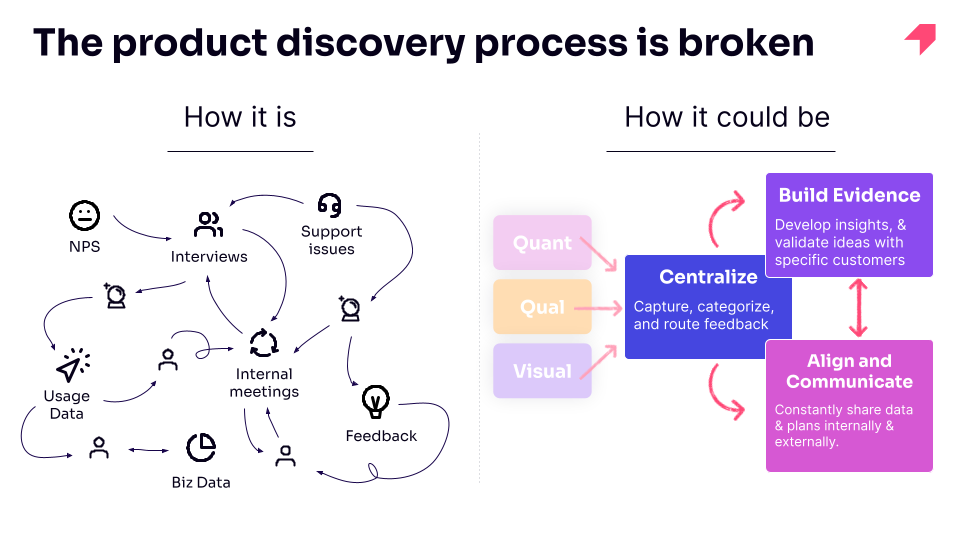迅速にリリースする—ただし、プロダクトが使いやすいこと。かっこいい新機能を開発する—ただし、限られた予算で。そして、競合他社と同等であるだけでなく、競合他社のプロダクトよりも優れたパフォーマンスを発揮し、より早く市場に投入できるようにしなければなりません。
When speed and urgency are at the forefront of leadership’s minds, it can be easy for product managers (PMs) to throw their hands up and say, “We don’t need to waste time with product discovery, we already know our users!” But not prioritizing product discovery—or not approaching it the right way—can have serious implications for your product, from bad product-market fit to bugs to features that go unused.
多くのチームにとってプロダクトディスカバリー(発見)プロセスが機能していない4つの主な原因と、再現可能で信頼性の高いデータ駆動型のディスカバリーエンジンを作成するためにプロセスを改善する方法を探ってみましょう。
1. プロダクトディスカバリーをまったく行っていない
According to our research, about 80% of software products are rarely or never used. That’s an astonishing $29.5B of wasted R&D spend each year. If your team doesn’t leverage any kind of product discovery tactics, it’s likely that your product is part of this statistic. Product discovery is an important step teams can take to mitigate risks and reduce the chances of developing a product that fails to meet user expectations or market demands.
In the era where digital experiences are king, not prioritizing product discovery can result in your product—and your entire organization—coming across as “tone deaf” to user desires, or incapable of delivering the offerings your customers actually need to succeed in their roles. But by conducting thorough product discovery, you can gain an objective understanding of what your users actually want, make smarter decisions about where to focus your time and resources, and identify potential challenges early in the product development process. This ultimately saves you from making poor investments or expensive (even reputation-ruining) missteps.
プロダクトディスカバリーは、プロダクト開発プロセスをビジネスの包括的な目標に合わせるための貴重なツールでもあります。時間をかけてユーザーのニーズを理解し、そのニーズを満たすための最善の道筋を考え、計画されたソリューションが会社の大きな目標に確実につながるようにすることで、プロダクトチームは、プロダクトの可視性と組織全体の成功への効果を最大限に高めることができます。
2. すべてのノイズをふるいにかけることができない
プロダクトディスカバリーに関しては、多くのプロダクトチームが恐ろしい「分析麻痺」に悩まされています。言い換えれば、彼らは多くの場合、複数の異なるツールに収容され、多数の異なるソースから発信された膨大な情報の海を泳いでおり、それに基づいてどのように行動すればよいのか明確なアイデアがないのです。
With the abundance of data available (e.g. product usage, customer and seller feedback, and market intelligence, just to name a few), it’s not uncommon for product teams to struggle to make sense of all this information. This slows down the entire product discovery and development process, and even leads PMs to fall back on biases in their decision-making in an attempt to find a direction to start moving in.
The best product discovery tools help product teams distinguish between valuable insights and noise. It’s not enough to simply listen to the loudest opinion or most common topic that arises from user focus groups. Nor is it enough to periodically take a pulse from your voice of the customer (VoC) program. Today, product teams need continuous discovery that unifies all the quantitative, qualitative, and visual data at their disposal in a single platform—making it easier and more efficient for them to identify themes and act on them. Pendo Listen was designed to solve this problem, by helping teams centralize feedback (in all its forms), prioritize it, and communicate updates to internal and/or external stakeholders, at scale—creating a holistic resource for continuous product discovery.
3. 適切なシグナルを捉えていない
Another common struggle is not leveraging the right data sources for product discovery—in other words, not capturing the right signals to make the best, informed decisions. For example, some teams over index on anecdotal feedback from customers or solely rely on feedback from user interviews to determine what to prioritize in their product. But without other quantitative, objective inputs like product analytics or session replays, they’re lacking a complete view into the user experience to guide their discovery.
Verifying ideas effectively before investing significant resources in development can also be challenging for product teams. In other words, even a team’s best laid plans can backfire because they’re unable to validate the efficacy of their new offerings before rolling them out across their entire user base. Validate—part of Pendo Discover—solves this problem.
Once you have an idea of the problems your customers face (and potential solutions to solve them), Validate helps you know what to build—and why. It allows product teams to prioritize and justify product investments by collecting in-app feedback from specific customers who rank the options you present to them. This makes it easy to verify and test ideas at scale, before a full rollout.
4. プロダクトライフサイクルの背景を考慮してディスカバリーを考えていない
Building great products doesn’t end at go-live. In the same way that the product management life cycle is cyclical and continuous, so is product discovery. But many product teams struggle to find the time to incorporate discovery into their ongoing optimization efforts. It’s also not uncommon for product teams to view product discovery as something that only needs to happen before launching a new product or feature—rather than something that continually informs their strategy.
プロダクトライフサイクル全体を通じて、PMは機能、アップデート、修正について戦略的な決定を下す必要があります。自由に使えるすべての定量的および定性的データから得られるプロダクトディスカバリーのインサイトに根ざした、情報に基づいた意思決定により、ユーザーと市場の進化するニーズに合わせた選択が可能になります。また、市場やユーザーのニーズは変化する可能性があるため、継続的なディスカバリーにより、プロダクトチームが適切なものを開発し、カスタマージャーニーのあらゆる段階で顧客の要望に対応できるように適応し、後れを取ることがなくなります。
Even when it comes to sunsetting products or features, product discovery can help in deprecation planning, managing customer transitions, and exploring opportunities for new products or features. Because Pendo Listen is designed to help teams collect and act on product insights (and communicate subsequent plans), it’s a powerful tool to enable discovery at every stage of the product life cycle. It allows you to share evidence as you uncover it, keep stakeholders updated on requests, and build easy-to-share roadmaps—while keeping everyone aligned throughout the process.
If you want to improve how your team does product discovery, take a tour of Pendo Listen or request your demo.

![[object Object]](https://cdn.builder.io/api/v1/image/assets%2F6a96e08774184353b3aa88032e406411%2F16b6f2565d1d4a5585db322386f9be7f?format=webp)
![[object Object]](https://cdn.builder.io/api/v1/image/assets%2F6a96e08774184353b3aa88032e406411%2F728d67faa5f64299b8f8f0b138881fb5?format=webp)
![[object Object]](https://cdn.builder.io/api/v1/image/assets%2F6a96e08774184353b3aa88032e406411%2Fc08c4160a2724c4fa3d365eb43791b09?format=webp)
